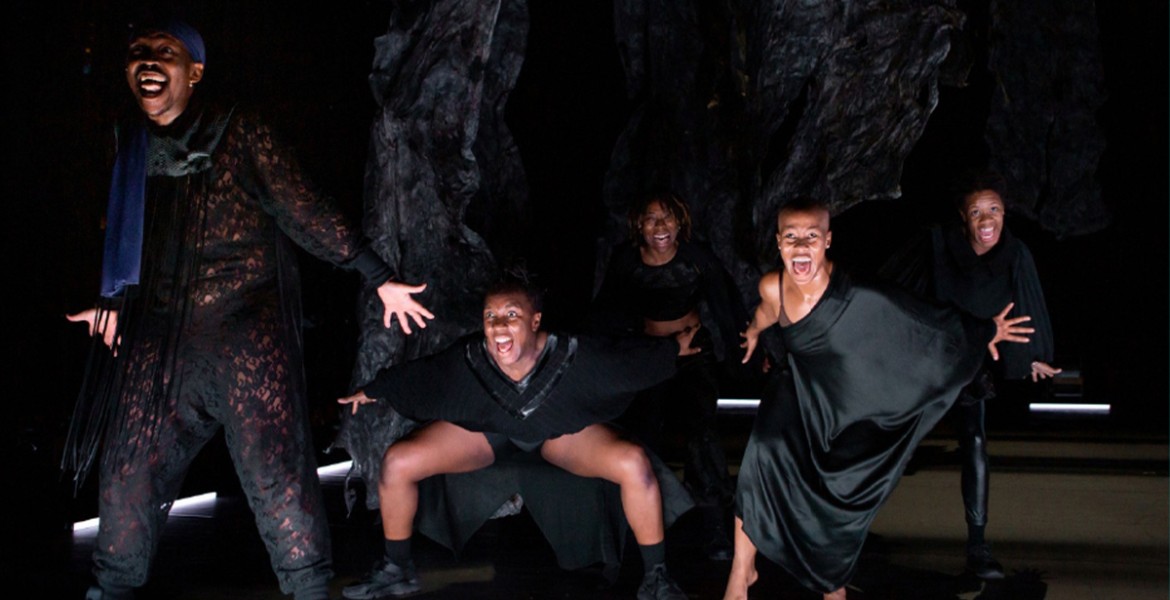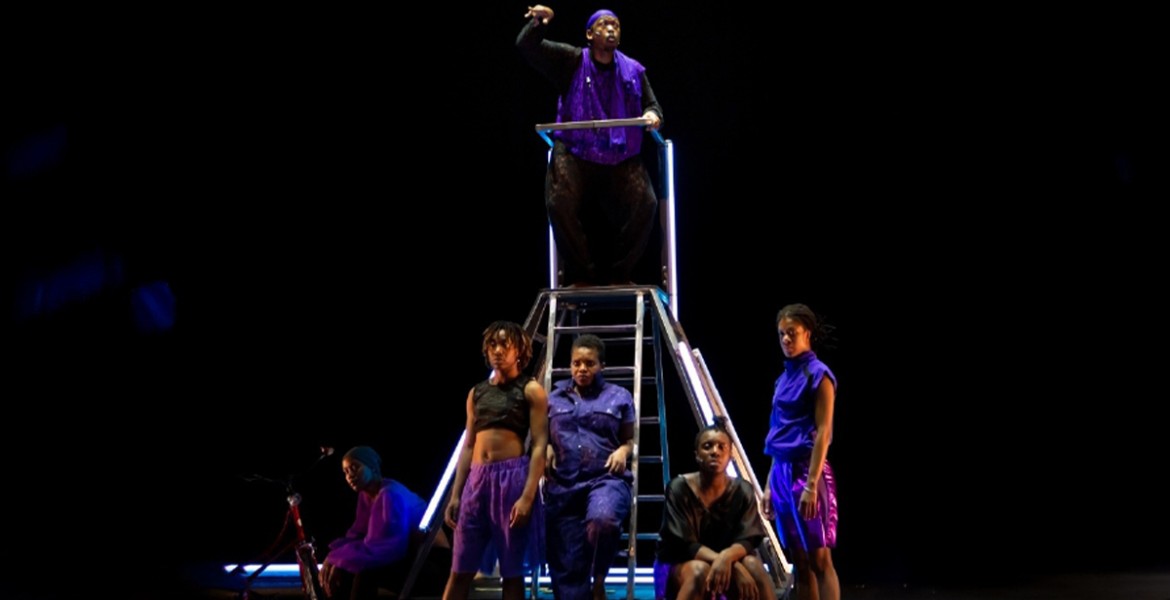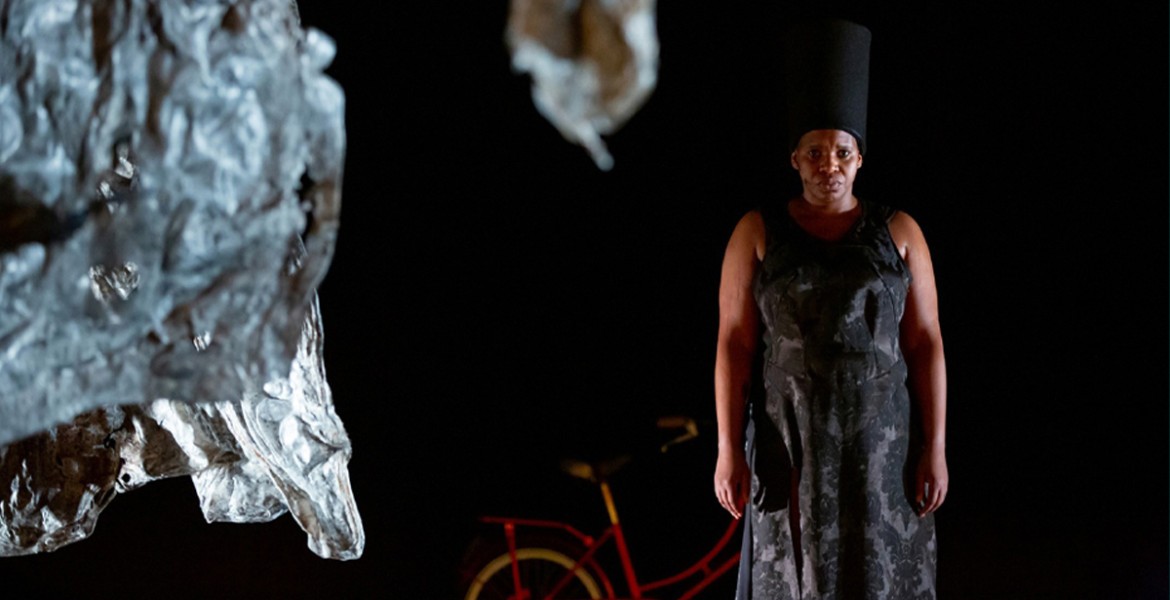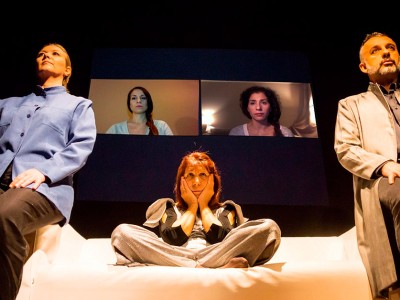Point Of View
Mimi’s Shebeen, της Alesandra Seutin - Κριτική
Νάγια Παπαπάνου[...] αυτό είναι το Σεμπίν¹ της Μίμι
χορεύουμε, συζητάμε, βάζουμε τη ζωή μας εδώ κάτω
μπορούν να ανατρέψουν τα πάντα
αλλά όχι το χαμόγελό μας
αυτό είναι το Σεμπίν της Μίμι
όλα είναι μοβ εδώ
μια ζωή που ζήσαμε στην άκρη της γλώσσας μας
μια υπόσχεση, μια εικόνα. [...]²
Στο θέατρο KVS, μια μεγαλοπρεπής φιγούρα στο κέντρο μιας υποφωτισμένης σκηνής, επιβλέπει τα σώματα που αναδύονται κάτω από σωρούς που φαντάζουν σαν χώμα. Τα σώματα των ερμηνευτών γεμίζουν τον χώρο καθώς η φιγούρα της «Μίμι» απευθύνει τα λόγια της στο κοινό και οι χωμάτινοι όγκοι αναλύονται ανεβαίνοντας στην κορυφή της σκηνής προσφέροντας μια νέα προοπτική σε αυτήν.«Στο Σεμπίν, η μνήμη κινείται και η αντίσταση χορεύει» δηλώνει η Alesandra Seutin, και πράγματι αυτό το χοροθεατρικό έργο είναι για την τραγουδίστρια της Νότιας Αφρικής Μίριαμ Μακέμπα, αλλά η ιστορία της ξεδιπλώνεται χωρίς σύνορα ή φραγμούς, λαμβάνοντας υπόψη την αίσθηση, τη εμπειρία και το συναίσθημα της παγκόσμιας μνήμης.
Το σκηνικό του Stef Stessel είναι ενδεικτικό της σκηνοθετικής πρόθεσης και της κίνησης: ο μεταλλικός πύργος περιβάλλεται από τους όγκους που όπως κατευθύνονται προς τα πάνω, γεμίζουν την ατμόσφαιρα, και τα σώματα κινούνται σαν ανθρώπινα καραβάνια από το ένα μέρος στο άλλο. Υπάρχουν πολλές δυνατές στιγμές. Μοναδικές ερμηνείες που συγχωνεύουν ένα ρευστό συναίσθημα και μια κυκλική κίνηση. Η Tutu Puoane είναι συγκινητική και δυναμική. Ο Kopano Maroga έχει έναν κοφτερό μονόλογο όπου η ετυμολογία της λέξης country (=χώρα) γίνεται ένα πανούργο μάντρα. Η Nosiphiwo Samente διαθέτει μια ερμηνευτική γενναιοδωρία που σαγηνεύει. Οι Nandi Bhebhe, Rose Aida Sall Sao και Kenza Deba είναι εξίσου μοναδικές και όμορφες επί σκηνής. Η ιδέα και η χορογραφία της Alesandra Seutin κινούν αυτούς τους ερμηνευτές σε μια παράλληλη κυκλική κίνηση, σαν τεκτονικές πλάκες που πλησιάζουν και απομακρύνονται ταυτόχρονα. Η δύναμη της κίνησης, η πιθανότητα σύγκρουσης, η υπόνοια κατάρρευσης μόνο και μόνο για να αναζωπυρωθεί η κίνηση, προσφέρουν μια ποιητική αναλογία επί σκηνής. Η μουσική των Angelo Moustapha και Zouratié Koné και ο τρόπος με τον οποίο οι μουσικοί μετέχουν οργανικά στην παράσταση δημιουργούν ένα ακόμα επίπεδο στην σαγηνευτική αιχμαλωσία του θεατή.
Η Lisette Ma Neza και ο Lebo Mashile παρέχουν το κείμενο. Κατά τη διάρκεια της παράστασης εκτιθέμεθα σε ηχητικά αποσπάσματα από ιστορικές στιγμές, όπως οταν η Makeba απευθύνεται στα Ηνωμένα Έθνη. Σε ένα σημείο δηλώνεται ότι δονούμαστε και η δόνηση δημιουργεί ρυθμό και ο ρυθμός θεραπεύει. Ο ρυθμός του κειμένου στο σημείο όπου “παίζει”με την ετυμολογια και κάνει λογοπαίγνια γύρω από τις λέξεις «χώρα», «εξορία» και «απαρτχάιντ» είναι βασανιστικός και οξύς, μετασχημάτιζει τις λέξεις σε μπαγκέτες που χτυπούν ανελέητα τη ράχη των βιβλίων πολιτικής ιδεολογίας. Ο δραματουργός εκτός από την επεξεργασία των ιδεών και των μέσων για την επικοινωνία τους, καθώς και τη διερεύνηση της διαδικασίας δημιουργίας και τελειοποίησης του έργου, στο δε χοροθέατρο μπορεί να είναι θεμελιώδης για το «πώς» θα βιωθεί η παράσταση από το κοινό. Πιστεύω ότι η δραματουργία του Gerardo Salinas έδωσε μια προοπτική στην εμπειρία μου που προσομοιάζει την κίνηση του σκηνικού προς τα πάνω, δημιουργώντας μια απόσταση από την καταπίεση του συναισθήματος σε μια ολιστική κατανόηση της ευρύτερης εικόνας.
Το «Mimi’s shebeen» ήταν μια εμπειρία που θα κρατήσω στην μνήμη μου. Διαφορετική, εύγλωττη, δυνατή και τρυφερή. Δεν είναι περίεργο που παρουσιάζεται εδώ και δύο χρόνια.
¹ Το καθεστώς του Απαρτχάιντ απαγόρευε στους μαύρους να πίνουν ή να συζητούν για πολιτική: η μόνη τους δουλειά ήταν να εργάζονται. Για να ξεπεράσουν αυτόν τον περιορισμό, οι ακτιβιστές αναζήτησαν ανακούφιση σε υπόγειες καλύβες και μπαρ, όπου αγόρια φρουρούσαν και τα ποτά φυλάσσονταν σε κρυφές αποθήκες. Έφτιαχναν Umqombothi, μια μπύρα με βάση το καλαμπόκι. Εάν η αστυνομία ανακάλυπτε ένα shebeen, το έκλεινε αμέσως και συνελάμβανε όλους τους εμπλεκόμενους. Τα περισσότερα shebeen διοικούνταν από γυναίκες, γνωστές ως «βασίλισσες των shebeen».
² Στίχοι από το κείμενο της παράστασης, μετάφραση από το αγγλικό κείμενο από την γράφουσα
Mimi’s Shebeen, by Alesandra Seutin - Review
[...] this is a Mimi Shebeen¹
we dance, we discuss, we lay our lives down here
they can turn everything upside down
but not our smile
this is a Mimi Shebeen
everything is purple here
a life lived on the tips of our tongues
a promise, a picture. [...]²
At the KVS theater a majestic figure at the center of a darkening stage oversees the bodies that emerge under piles of earth like rags. The bodies of the performers fill in the space as the figure of “Mimi” projects her words to the audience and the earthly rags start ascending to the top of the stage offering a new perspective to the scene. “In the Shebeen, memory moves and resistance dances” states Alesandra Seutin, and indeed this dance theatre play about South African singer Miriam Makeba, is more than about her story, it is a history unfolding, without borders or barriers taking into the feeling, the remembrance and the sentiment of universal memory.
The setting of Stef Stessel is indicative of structure and movement: the metallic tower is surrounded by the rags that are filling the atmosphere, and the bodies are moving like caravans from one place to the other. There are lots of powerful moments; unique performances that amalgamate a fluent emotion and circular motion. Tutu Puoane is moving and powerful. Kopano Maroga has a sharp soliloquy where the etymology of country becomes a cunning mantra. Nosiphiwo Samente has a performative generosity that captivates. Nandi Bhebhe, Rose Aida Sall Sao and Kenza Deba are equally unique and beautiful on stage. The concept and choreography of Alesandra Seutin moves these performers in a circular motion, much like tectonic plaques that are coming closer and moving away at the same time. The power of the motion, the possibility of collision, the hint of collapse only to re-ignite the movement provide a poetic analogy on stage. The music of Angelo Moustapha and Zouratié Koné and the way that the musicians organically give into the performance creates an additional layer of mighty captivation.
Lisette Ma Neza and Lebo Mashile provide the text, and during the show we are exposed to audio clips of historical facts, like Makeba addressing the United Nations. At a point it is stated that we are vibrating and vibration makes rhythm and the rhythm is healing. The rhythm of the text with the etymological and wordplay around “country”, “exile” and “apartheid” was excruciating and sharp, it transcended the words to drumsticks relentlessly beating on the spine of political ideology books. The dramaturg except for working into the ideas and the means for their communication, as well as exploring the process to create and refine work, in dance theatre they can be fundamental to the “how” the performance will be experienced by the audience. I believe that the dramaturgy by Gerardo Salinas has given a perspective to my experience that imitated the movement of the setting upwards, creating a distance from the oppression of emotion towards a holistic understanding of the bigger image.
“Mimi’s shebeen” has been an experience for me to treasure. Different, eloquent, powerful and tender. It is no wonder it has been presented for two years now.
¹ The Apartheid regime forbade Black people from drinking or talking about politics: their only job was to work. To overcome this restriction, activists sought reprieve in underground huts and bars, where boys stood guard and drinks were stashed in hidden storage rooms. They would brew Umqombothi, a corn-based beer. If the police discovered a shebeen, they would immediately shut it down and arrest all those involved. Most shebeens were run by women, known as ‘shebeen queens’.
² Lines from the text of the performance, also depicted at the online program
Credits
CONCEPT & CHOREOGRAFIE / CONCEPT & CHORÉGRAPHIE / CONCEPT & CHOREOGRAPHY Alesandra Seutin MUZIEK / MUSIQUE / MUSIC Angelo Moustapha & Zouratié Koné TEKST / TEXTE / TEXT Lisette Ma Neza & Lebo Mashile PERFORMANCE / INTERPRÉTATION Tutu Puoane, Nandi Bhebhe, Kopano Maroga, Nosiphiwo Samente, Hendrickx Ntela/Shorlady Preciado / Kenza Deba, Elaisa van der Kust/Rose Sall Sao DRAMATURGIE / DRAMATURGY Gerardo Salinas SCENOGRAFIE / SCÉNOGRAPHIE / SCENOGRAPHY Stef Stessel ASSISTENTE SCENOGRAFIE / ASSISTENT SCENOGRAPHY Ine Van Bortel KOSTUUMS / COSTUMES Caroline Fainke SOUNDSCAPE / PAYSAGE SONORE Hans Mullens LIGHT DESIGN / CONCEPTION LUMIÈRES / LIGHTING DESIGN Margareta Andersen & Stef Stessel GELUIDSONTWERP / CONCEPTION SON / SOUND DESIGN Diederik De Cock GELUID/ SON / SOUND &MONITOR MIX Patrick Van Neck STEMCOACH / COACH VOCAL / VOCAL COACH Randolph Matthews PRODUCTIELEIDING / DIRECTEUR DE PRODUCTION / PRODUCTION MANAGER Ella De Gregoriis / Tanja Vrancken TONEELMEESTER / RÉGISSEUR / STAGE MANAGER Raphael Noel MACHINERIE / MACHINERY Christophe Geens ASSISTENT VAN DE CHOREOGRAAF / ASSISTANT·E DE LA CHORÉOGRAPHE / ASSISTANCE TO THE CHOREOGRAPHER Nandi Bhebhe MUZIKALE ONDERSTEUNING / SUPPORT MUSICAL / MUSICAL SUPPORT Tarang Cissokho ONDERZOEK / RECHERCHE / RESEARCH Kopano Maroga WORKSHOP FACILITATOR / FACILITEUR D'ATELIER Rokia Bamba BIJKOMENDE STEUN / SOUTIEN ADDITIONNELLE / ADDITIONAL SUPPORT Uprise Rebel BOVENTITELING / SURTITRAGE / SURTITLING Inge Floré VERTALING / TRADUCTION / TRANSLATION Anne Vanderschueren, Alex Stockman SPREIDING & TOURMANAGEMENT / DIFFUSION & DIRECTEUR·RICE DE TOURNÉE / DISTRIBUTION & TOUR DIRECTION Cecilia Kuska & Inge Jooris STAGIAIRE TECHNIEK Seppe Lauwereyns PRODUCTIE / PRODUCTION Vocab Dance & KVS COPRODUCTIE / COPRODUCTION Perpodium, Sadler's Wells London MET DE STEUN VAN / AVEC LE SOUTIEN DE / WITH THE SUPPORT OF de Belgische Federale Overheid via Cronos Invest
Tıckets and the Dıgıtal booklet: Mimi’s Shebeen - Political Cabaret at KVS Brussels | Unique Performance
Who is Miriam Makeba?
Zenzile Miriam Makeba (4 March 1932 – 9 November 2008), nicknamed Mama Africa, was a South African singer, songwriter, actress, and civil rights activist. She had a life of remarkable global impact. She contributed to Black people’s struggle for liberation and defended the integrity of African identity and artistry while living in a land absent of her ancestry.
political activism brought her to testify before the United Nations in 1963, after which her records were banned in South Africa. In the late 60s she became ostracized in the US and she took refuge in Guinea, where she lived until 1985 before moving to Brussels. In 1990, after 30 years in exile, she returned to her native South Africa at Nelson Mandela’s invitation. She died in Italy in 2008.
World hit
Miriam Makeba was one of the first to introduce African music to a Western audience. Her biggest hit was the song Pata Pata (1967). With her fame, she prepared the way for other African artists such as Youssou N’Dour and Fela Kuti. Makeba successfully toured Europe and the United States, and in 1987 she joined Paul Simon’s Graceland tour.
ΔΙΑΒΑΣΤΕ ΑΚΟΜΑ

Απόστολος Κίτσος Live
Την Πέμπτη 20 Νοεμβρίου στον Σταυρό του Νότου Plus. Special Guest η Ελένη Τσαλιγοπούλου!
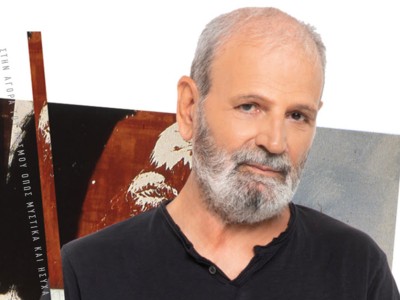
Νίκος Ζούδιαρης | Α' και Β΄ Ανάγνωση
Το Σάββατο 1 Νοεμβρίου ο Νίκος Ζούδιαρης θα παρουσιάσει στον Φιλολογικό Σύλλογο Παρνασσού ένα πρόγραμμα με τίτλο Α' και Β΄ Ανάγνωση....
Σχόλια χρηστών
Για να συμμετέχετε στην συζήτηση πρέπει να γίνετε μέλη. Λάβετε μέρος σε κάποια συζήτηση κάνοντας roll-over στο αρχικό σχόλιο και πατήστε το κουμπί "Απάντηση". Για να εισάγετε ένα νέο σχόλιο χρησιμοποιήστε την φόρμα στο τέλος της λίστας.

